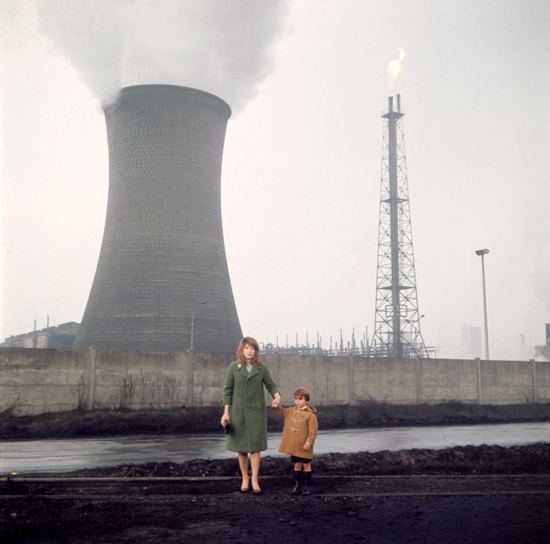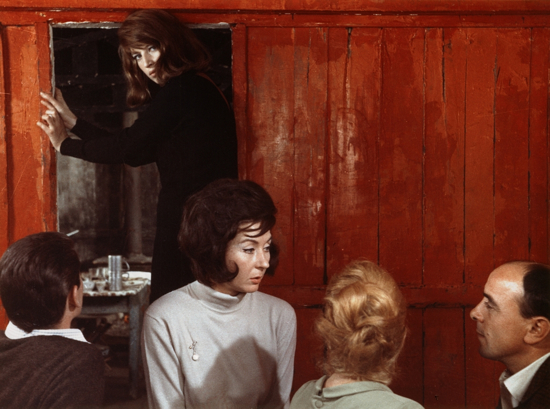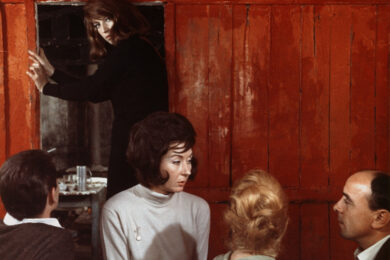Red Desert centres on a neurotic Italian woman who is losing her grip. She is trapped in a loveless, flat marriage and attracted to a restless Richard Harris. She feels increasingly alienated by the onset of soulless industrialism and heartless modernity, and utters such dazed, gnomic asides as, "There is something terrible in reality and I don’t know what it is." Hey, who among us cannot relate to that? This is a high point in experimental, abstract cinema – not an easy watch, it is wilfully feel-bad – and yet 48 years after its original release it seems to say an awful lot about the world we wouldn’t want to live in but do. Not that it is realistic. It is hyper-real at times, but ridiculously, operatically romantic in places. It was Michelangelo Antonioni’s first film in colour, but neither his first nor last to invent new ways of seeing.
In terms of Antonioni’s career, it’s referenced as the transition film between the sublime early Sixties trio of L’Avventura (1960), La Notte (1961) and L’Eclisse (1962) and his subsequent English language work: Blow Up (1966), Zabriskie Point (1970), The Passenger (1975). L’Eclisse had ended in a stunning montage of missed connections and deserted locations, highlighting – through absence – the absence of a future for the two lovers of its tale. Red Desert then won the Golden Lion at the Venice Film Festival in 1964 and was pitched as a jaunty sex comedy (see trailer below), which it is not. It begins with a woman and child walking through a grey, barren, chemical plant landscape, hungry for bread. The soundtrack is an unsettling mess of drones, bleeps, bangs and foghorns which simmers throughout, even in the most incongruous scenes. The woman is Giuliana, played by Monica Vitti.
Vitti, the director’s muse and lover, had appeared in the previous three movies, defining their intelligent unease: in this one her hair is dyed red. Antonioni embraced colour but didn’t really know how to use it. His experiments and ‘errors’ led to a film which, even judged in visual terms alone, is outstanding and unique. He took shots out of focus, to obfuscate the backdrops, but also had grass, trees, streets and fruit painted to enhance their aura. There are frequent, gratuitous flashes and washes of red which break the fourth wall and allow Red Desert to succeed as a tone poem as much as an insight into humans under pressure in a frightening world.
That Vitti is an iconic screen presence is beyond doubt. Was she a good actress? There are spells in Red Desert where she is on fire: twitching, pulling her arms around herself, pressing against walls, eyes darting, nails chewed, shivering, manic. There are also spells where Antonioni asks her to sell too much of the story (such as it exists) and she comes across as a hammy, self-obsessed basket case. As everyone around her is so laid-back and understated – Harris, the singer of ‘MacArthur Park’, appears to have left his cake out in the rain and sullenly phones in his role (indeed his Italian was dubbed) – this is troubling, but then again so is the film, intentionally.
The meta-narrative is secondary to the set pieces and the philosophical riffs on dislocation and loneliness, but goes as follows. Giuliana (Vitti), torn between nature and machinery, between impulse and technology, has recently survived a car accident which, it is hinted, may have been a suicide attempt. Says her detached husband Ugo (Carlo Chionetti), manager of the power plant where vast plumes of smoke belch symbolically, "She was shocked, and she still can’t… mesh." Listening to him say this is new colleague Zeller (Harris), who is attracted to her prickly energy. He strolls around the ancient streets of Ravenna with her, discussing big themes, fanning their sexual tension. They ponder paint colours for the shop she dreams of opening. Self-referentially, she wants "cold, non-disturbing colours", adding, "I’m always tired. Not always. Sometimes." It’s the self-awareness of the dialogue that gives it endurance, rendering Antonioni harder to parody than many existential art house masters. A hollow piece of pretension would just have her say she was always tired, because life is such a ghastly relentless grind. The Antonioni-Vitti cypher has to qualify it, has to get it just right.
We then leap to a bizarre extended ‘orgy’ scene. It’s not what you’re thinking: the ‘Swinging London’ of Blow Up isn’t here yet. It is, though, an indelibly memorable sequence, with a cast of faintly macabre characters oscillating madly between laughter and angst, between sex-farce and Bergman, between The Monkees and Munch. People flirt, letch, try aphrodisiacs, then the next moment discuss what they believe in and gaze at the looming great ships which closely pass by their tiny, intimate dockside hut. It’s bright red on the interior, grey on the exterior. As any attempt at a linear thread collapses (all the tropes of erotic malaise have been vacuously enacted, but in random order), Harris ‘accidentally’ kicks his foot through the wooden wall and things – quite literally – fall apart. The group start to tear up their location for firewood, until they lose interest in being so post-modern. Vitti expresses a desire to make love. Nobody’s especially interested, so she stares out at the sea and announces, "It never keeps still. Never. Never. I can’t look at the sea too long, otherwise I lose interest in what happens on land."
Antonioni is playing with us there, testing our patience and our willingness to let go of traditional storytelling techniques, but now sucker-punches us with a breathtaking moment. A thick, grisly fog descends, in which Giuliana is momentarily lost, until she sees all the other characters staring at her. Sinister, surreal, and yet arrived at thoroughly logically, it depicts her state of mind with a brushstroke of genius.
The next scenario has Giuliana and Ugo at home with their little boy, who seems keen on science-related toys like gyroscopes. Oh, the corruption of innocence! He falls sick, or feigns sickness, and Giuliana is more rattled than ever, again haunted by this looming great ship which keeps following her around like Moby Dick or something. The child asks for a story, so she tells one about a young girl enjoying an idyllic beach – solitude, golden sand, clear blue water – interrupted only by mysterious voices. For this ‘fantasy’ scene (which represents the way she wishes the exterior world was), the colours become sumptuous, dazzling, textbook, picture postcard. In the context of such an unremittingly bleak film, it’s a lightning strike of hope, and a coup de cinema.

Our anti-heroine has lost it now though, and runs around forgetting who she is, flitting between intense vulnerability and wanton aggression. The breakdown is on. She runs to Zeller, telling him that "my hair hurts, my eyes hurt" and that she must be an idiot for needing the affection of others so much. "I’ve not been cured. I never shall be." They engage in a ‘sex scene’, although it’s fragmented, bitty, despondent, anything but passionate, and leaves her no less dejected. Finally, revisiting the barren ‘progress’ of the power plant, she tells her son that the birds have learned not to fly through the toxic yellow smoke. Historically, some readings of the film have claimed this as optimism: she too has learned. Others have suggested that the birds may have learned but she cannot. The toxic yellow smoke is going to win and crush all delicate flowers.
There is tremendous, graceful style in the anti-style of Red Desert. Its blend of cupidity and psyche is harrowing, disturbing, but brave and – for all its nihilistic nonchalance – profoundly affecting. Its preoccupations resonate today and its poetry is indisputable. It is without doubt one of the most intriguing, awkward and powerful films ever made.
Red Desert opens in selected cinemas nationwide today; a full list of screenings can be found here.




